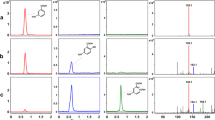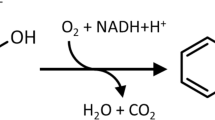Abstract
Catechol 2,3-dioxygenase (C23O), an extradiol-type dioxygenase cleaving the aromatic C—C bond at the meta-position of dihydroxylated aromatic substrates, catalyzes the conversion of catechol to 2-hydroxy-muconic semialdehyde. Based on a curing experiment, PCR identification, and Southern hybridization, the gene responsible for C23O was localized on a 3.5-kb EcoRI/BamHI fragment and cloned from Pseudomonas aeruginosa ZD 4-3, which was able to degrade both single and bicyclic compounds via a meta-cleavage path-way. A complete nucleotide sequence analysis of the C23O revealed that it has one ORF, which showed a strong overall amino acid similarity to the known gram-negative bacterial mesophilic C23Os. The alignment analysis indicated a distinct difference between the C23O in this study and the 2,3-dihydroxybiphenyl dioxygenases that cleave bicyclic aromatic compounds. The heterogeneous expression of the pheB gene in E. Coli BL21(DE3) demonstrated that this C23O possesses a meta-cleavage activity.
Similar content being viewed by others
REFERENCES
P.U.M. Raghavan M. Vivekanandan (1999) ArticleTitleBioremediation of Oil-Spilled Sites through Seeding of Naturally Adapted Pseudomonas putida Int. Biodeterioration Biodegradation 44 29–32
M. Romantschuk I. Sarand T. Petanen R. Peltola M. Jonsson-Vihanne T. Koivula K. Yrjala K. Haahtela (2000) ArticleTitleMeans To Improve the Effect of In Situ Bioremediation of Contaminated Soil: An Overview of Novel Approaches Environ. Pollut. 107 179–185
J.R. Meer W.H. Vos S. Harayama A.J.B. Zehnder (1992) ArticleTitleMolecular Mechanisms of Genetic Adaptation to Xenobiotic Compounds Microbiol. Rev. 56 6776–6794
A. Wasserfallen M. Rekik S. Harayama (1991) ArticleTitleA Pseudomonas putida Strain Able To Degrade m-Toluene in the Presence of 3-Chlorocatechol Bio/Technology 9 296–298
P. Cerdan A. Wasserfallen M. Rekik K.N. Timmis S. Harayama (1994) ArticleTitleSubstrate Specificity of Catechol 2,3-Dioxygenase Encoded by TOL Plasmid pWW0 of Pseudomonas putida and Its Relationship to the Growth of Host Cells J. Bacteriol. 176 6074–6081
A. Okuta K. Ohnishi S. Harayama (1998) ArticleTitlePCR Isolation of Catechol 2,3-Dioxygenase Gene Fragments from Environmental Samples and Their Assembly into Functional Genes Gene 212 221–228
Y.-X. Chen H. Liu H.-L. Chen (2003) ArticleTitleCharacterization of Phenol Biodegradation by Comamonas testosteroni ZD 4-1 and Pseudomonas aeruginosa ZD 4-3 Biomed. Environ. Sci. 16 163–172
J. Sambrook E.F. Fritsch T. Maniatis (1989) Molecular Cloning: A Laboratory Manual EditionNumber2nd ed. Cold Spring Harbor Lab. Cold Spring Harbor
T. Fujii M. Takeo Y. Maeda (1997) ArticleTitlePlasmid-Encoded Genes Specifying Aniline Oxidation from Acinetobacter sp. Strain YAA Microbiology (UK) 143 93–99
B.R. Glick J.J. Pasternak (1994) Molecular Biotechnology: Principles and Applications of Recombinant DNA ASM Press Washington, DC
L.F. Soler J. Cedano E. Querol R. Llorens Particlede (2003) ArticleTitleCloning, Expression and Purification of Human Epidermal Growth Factor Using Different Expression Systems J. Chromatogr. B, Analyt. Technol. Biomed. Life Sci. 788 113–123
R.S. Burlage S.W. Hooper G.S. Sayler (1989) ArticleTitleThe TOL (pWW0) Catabolic Plasmid Appl. Environ. Microbiol. 55 1323–1328
K. Yrjala L. Paulin S. Kilpi M. Romantschuk (1994) ArticleTitleCloning of cmpE, a Plasmid-Borne Catechol 2,3-Dioxygenase-Encoding Gene from the Aromatic-and Chloroaromatic-Degrading Pseudomonas sp. HV3 Gene 138 119–121
F.M. Duffner R. Muller (1998) ArticleTitleA Novel Phenol Hydroxylase and Catechol 2,3-Dioxygenase from the Thermophilic Bacillus thermoleovorans Strain A2: Nucleotide Sequence and Analysis of the Genes FEMS Microbiol. Lett. 161 37–45
L.D. Eltis J.T. Bolin (1996) ArticleTitleEvolutionary Relationships among Extradiol Dioxygenases J. Bacteriol. 178 5930–5937
S. Harayama M. Kok E.L. Neidle (1992) ArticleTitleFunction and Evolutionary Relationships among Diverse Dioxygenases Annu. Rev. Microbiol. 46 565–601
Author information
Authors and Affiliations
Additional information
From Mikrobiologiya, Vol. 73, No. 6, 2004, pp. 802–809.
Original English Text Copyright © 2004 by Chen, Liu, Zhu, Jin.
This article was submitted by the authors in English.
Rights and permissions
About this article
Cite this article
Chen, YX., Liu, H., Zhu, LC. et al. Cloning and characterization of a chromosome-encoded catechol 2,3-dioxygenase gene from Pseudomonas aeruginosa ZD 4-3. Microbiology 73, 689–695 (2004). https://doi.org/10.1007/s11021-005-0010-2
Received:
Issue Date:
DOI: https://doi.org/10.1007/s11021-005-0010-2




